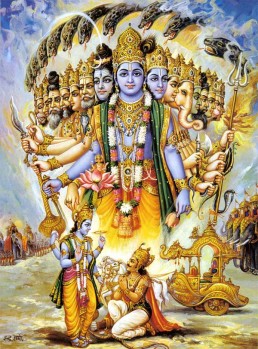Swami Chinmayananda
Swami Chinmayananda Commentary
Continuing the description of the Infinite as comprehended by the subtle perception of Arjuna and interpreted by his intellect in terms of the Universe of things and names, it is explained, “I SEE THEE WITHOUT BEGINNING, MIDDLE AND END, INFINITE IN POWER, OF INFINITE ARMS.” This pen-picture, drawn by Vyasa with his eloquent poetry, gives a false impression that the theme is an object, and many are the artists who have tried to capture this form on the canvas. The folly is clear to every intelligent student of Vedanta. That which is Infinite, without beginning or end, cannot be brought within the area of a limited canvas-piece. But, at the same time, the phrase “OF INFINITE ARMS” tickles the painter to express it through his own art. In fact, the Universal-Form, standing out so clearly in relief work in this transcendental apprehension of the author, can be comprehended only by students of deep understanding and developed intuition.
Here, by the term “OF INFINITE ARMS” it only means that the Supreme Self, as the dynamic life, is the one essential strength behind every hand that acts and achieves.
The “principle of light” is the very “principle” in the eye. If the eyes were not there, light itself would have no meaning. At the same time, if the “principle of light” were not blessing the objects of form, the instruments of cognition — the eyes — could not have functioned at all. We have here the description of the totality. The “principle of vision,” ie. all the eyes in the whole universe, is described as the pair-of-eyes, in the Universal-Form of the Lord. Therefore, in the technical language of Vedanta, it has been aptly described here that “THE SUN AND THE MOON ARE YOUR EYES.”BURNING FIRE OF YOUR MOUTH — Here fire has been considered as the principle behind speech and the principle governing taste. Warm food tastes better; frozen-food has no taste. The presiding deity of speech can FIRE the generation. HEATED discussions always take place; cold discussion is a painful monotony. Speeches that freeze the audience are only lullabies. And the mouth being the seat for both the instruments of speech and taste, the mouth of the Vishwaroopa is explained here as “Fire.”
HEATING THE WHOLE UNIVERSE WITH YOUR RADIANCE — The Self cannot but be luminous, because Consciousness illumines all experiences, at all times, in all living organisms. This light of Consciousness not only illumines, but also imparts the Warmth of life to the entire Universe. From the very statement it is evident that the ancient Hindu had turned his gaze inward only when he had exhausted his observations and study of the world outside. It seems that he knew well that at a certain degree of temperature alone life could continue on this globe; below the required minimum and above the maximum temperature, life would be extinct.
The light that is emanating from Truth is Its own light, and not something which It has derived from any other source. It is by “Your own Radiance” (Swa-Tejasa) that the life is sustained in the world of names and forms.
Adi Sankara Commentary
Pasyami, I see; tvam, You; as anadi-madhya-antam, without beginning, middle and end; ananta-viryam, possessed of infinite valour; and also ananta-bahum, having innumerable arms; sasi-surya-netram, having the sun and the moon as the eyes; dipta-hutasavakram, having a mouth like a blazing fire; tapantam, heating up; idam, this; visvam, Universe; sva-tejasa, by Your own birlliance.
The Bhagavad Gita with the commentary of Sri Sankaracharya – Translated by Alladi Mahadeva Sastry
Holy Geeta – Commentary by Swami Chinmayananda
The Bhagavad Gita by Eknath Easwaran – Best selling translation of the Bhagavad Gita
The Bhagavad Gita – Translation and Commentary by Swami Sivananda
Bhagavad Gita – Translation and Commentary by Bhaktivedanta Swami Prabupadha
Srimad Bhagavad Gita Chapter 11 – Verse 19 – 11.19 anadi madhyantam – All Bhagavad Gita (Geeta) Verses in Sanskrit, English, Transliteration, Word Meaning, Translation, Audio, Shankara Bhashya, Adi Sankaracharya Commentary and Links to Videos by Swami Chinmayananda and others – 11-19

